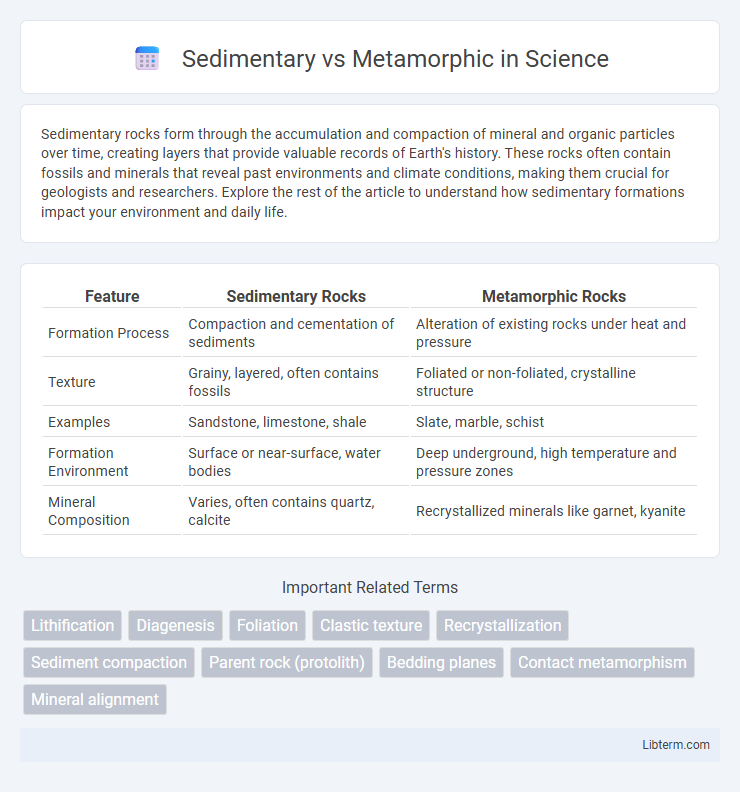Sedimentary rocks form through the accumulation and compaction of mineral and organic particles over time, creating layers that provide valuable records of Earth's history. These rocks often contain fossils and minerals that reveal past environments and climate conditions, making them crucial for geologists and researchers. Explore the rest of the article to understand how sedimentary formations impact your environment and daily life.
Table of Comparison
| Feature | Sedimentary Rocks | Metamorphic Rocks |
|---|---|---|
| Formation Process | Compaction and cementation of sediments | Alteration of existing rocks under heat and pressure |
| Texture | Grainy, layered, often contains fossils | Foliated or non-foliated, crystalline structure |
| Examples | Sandstone, limestone, shale | Slate, marble, schist |
| Formation Environment | Surface or near-surface, water bodies | Deep underground, high temperature and pressure zones |
| Mineral Composition | Varies, often contains quartz, calcite | Recrystallized minerals like garnet, kyanite |
Introduction to Sedimentary and Metamorphic Rocks
Sedimentary rocks form through the accumulation and compaction of mineral and organic particles, often preserving fossils and layering known as bedding. Metamorphic rocks originate from existing rock types transformed by heat, pressure, and chemically active fluids, altering their mineral composition and texture without melting. Common examples include sandstone and shale for sedimentary rocks, and schist and gneiss for metamorphic rocks.
Formation Processes of Sedimentary Rocks
Sedimentary rocks form through the accumulation and compaction of mineral and organic particles, often in water-rich environments like rivers, lakes, and oceans. These processes include weathering, erosion, deposition, and lithification, where sediments are compacted and cemented over time to create solid rock. In contrast, metamorphic rocks originate from the transformation of existing rocks under intense heat and pressure, altering their mineral composition without melting.
Formation Processes of Metamorphic Rocks
Metamorphic rocks form through the transformation of pre-existing sedimentary, igneous, or metamorphic rocks under intense heat, pressure, and chemically active fluids within the Earth's crust. This alteration process, known as metamorphism, modifies the mineral composition and texture without melting the rock, resulting in foliated or non-foliated structures. Common metamorphic rocks such as schist, gneiss, and marble illustrate the diverse outcomes of varying conditions during metamorphic formation.
Key Characteristics of Sedimentary Rocks
Sedimentary rocks are primarily characterized by their formation from the accumulation and compaction of mineral and organic particles, often exhibiting distinct layers or strata. These rocks typically contain fossils, providing valuable information about Earth's history and past environments. Their porosity and permeability make them important reservoirs for water, oil, and natural gas.
Distinct Features of Metamorphic Rocks
Metamorphic rocks exhibit distinct features such as foliation, resulting from intense pressure that realigns mineral grains into parallel layers, and recrystallization, which forms new mineral assemblages without melting the rock. These rocks typically show increased hardness and density compared to sedimentary rocks due to the heat and pressure conditions during metamorphism. Unlike sedimentary rocks, metamorphic rocks often lack fossils and original sedimentary structures, reflecting their transformation deep within the Earth's crust.
Common Examples of Sedimentary vs Metamorphic Rocks
Sandstone, limestone, and shale are common examples of sedimentary rocks formed from the accumulation and lithification of mineral and organic particles. Metamorphic rocks such as schist, gneiss, and marble originate when existing rocks undergo intense heat and pressure, causing physical and chemical changes. These distinctive rock types highlight the dynamic processes of earth's crust transformation over geological time.
Changes in Texture and Structure
Sedimentary rocks exhibit clastic or chemically precipitated textures characterized by visible grains, fossils, and layering or bedding planes. Metamorphic rocks undergo recrystallization under heat and pressure, altering original textures into foliated or non-foliated structures with interlocking mineral grains. These changes result in a more compact, crystalline appearance in metamorphic rocks compared to the often porous and layered texture of sedimentary rocks.
Geological Environments and Occurrences
Sedimentary rocks form primarily in depositional environments such as rivers, lakes, oceans, and deserts, where sediments accumulate through processes like weathering, erosion, and compaction. Metamorphic rocks develop in geological settings characterized by intense heat and pressure, including mountain roots, convergent plate boundaries, and deep crustal levels, transforming pre-existing rocks without melting. The occurrence of sedimentary rocks is widespread near Earth's surface, often hosting fossil records, whereas metamorphic rocks are typically found in orogenic belts and deep continental crust zones.
Economic and Environmental Significance
Sedimentary rocks, rich in fossil fuels like coal, oil, and natural gas, drive significant economic activities and provide essential resources for energy production. Metamorphic rocks often contain valuable minerals such as graphite, garnet, and talc, contributing to industries like manufacturing and construction. Environmentally, sedimentary rock extraction can lead to habitat disruption and groundwater contamination, whereas metamorphic mining requires careful management to prevent soil erosion and preserve biodiversity.
Conclusion: Comparing Sedimentary and Metamorphic Rocks
Sedimentary rocks form from the compilation and lithification of sediments, often containing fossils and layered structures, whereas metamorphic rocks result from the transformation of existing rocks under heat and pressure, displaying foliation or banding. Sedimentary rocks typically preserve geological history through embedded materials, while metamorphic rocks reveal the intense physical and chemical changes they have experienced. The distinct processes and characteristics highlight their unique roles in interpreting Earth's dynamic geological evolution.
Sedimentary Infographic

 libterm.com
libterm.com